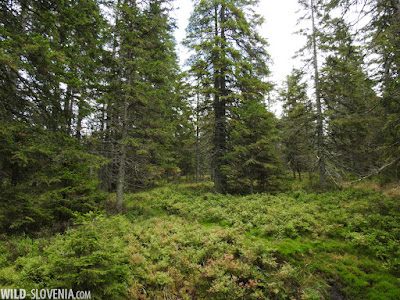This week we ventured further east from our usual circuits and spent two
days on the Pohorje plateau in northeastern Slovenia. The area is the
largest non-limestone plateau in the country and its highest peaks rise
to an altitude of about 1500 metres. Given its acidic soil composition,
Pohorje is covered by extensive conifer forests, interspersed with
raised bogs and smaller lakes. The typical boreal appearance strongly
reminds of the taiga forests. Many of the animals that live here are ice
age relicts, for example Capercaillie Tetrao urogallus, Black Grouse Lyrurus tetrix, Three-toed Woodpecker Picoides tridactylus, Tengmalm's Aegolius funereus & Pygmy Owl Glaucidium passerinum, Mountain Hare Lepus timidus, while among plants there are boreal species like Norway Spruce Picea abies, the various "berries" Vaccinium sp., Sphagnum mosses, Hare's-tail Cottongrass Eriophorum vaginatum
and many others.
 |
| Črno jezero (the Black lake). |
 |
| Mountain Pine Pinus mugo on a raised bog. |
 |
Round-leaved Sundew Drosera rotundifolia
|
 |
Bearded Bellflower Campanula barbata
|
 |
Hard Fern Blechnum spicant
|
 |
Boreal conifer forest on boggy grounds, covered with Sphagnum mosses.
|
 |
Drier conifer forest on sloping grounds with Bilberry Vaccinium myrtillus in the understorey.
|
We visited various forest reserves and bogs, including
areas with impressively high amounts of dead and decaying trees. It was a
paradise for conifer specialists such as Three-toed Woodpecker Picoides tridactylus...
in fact, while taking a stroll in an area of almost-primeval forest, we
came across two confiding males. Although
the light was really bad, both woodpeckers gave amazingly good views and we could observe
them at really close quarters. Actually we were standing right underneath the trees where they were feeding and
could even listen to the vibrations on the trees, produced by the
insistent pecking. One of the males also gave several spontaneous bursts of drumming
- a rather rare behaviour outside of spring.
 |
Impressive amounts of dead conifer wood, even outside forest reserves.
|
 |
The "woodpecker" - a clear sign for the lumberjacks, meaning that the tree stays up.
|
 |
And right there it was, our favourite bird...
|
Three-toed Woodpecker Picoides tridactylus, male.
 |
Watching a Three-toed at close distance.
|
 |
Listening to a Three-toed, pecking on the very same tree, a little higher up.
|
Other birds were typical
species of mountain conifer forests and actually we didn't see much
else. However we found several interesting plants we are not used to see
in the limestone mountains of western Slovenia. There were also several interesting fungi like the rare Coral Tooth Fungus Hericium alpestre, growing on dead Silver Firs Abies alba. Apart from visiting the conifer forests & bogs around Lovrenška jezera (Lovrenc's lakes) and Črno jezero (the
Black lake), we also descended to the plateau's
northeastern slopes to see the impressive Šumik waterfall in the Lobnica
gorge. What an amazing place! The whole plateau is certainly worth another visit in spring (for birds) and summer (for plants).
 |
Raven Corvus corax
|
 |
Fir Coral Tooth Fungus Hericium alpestre
|
 |
Cep Boletus edulis
|
 |
Fly Agaric Amanita muscaria
|
 |
The Lobnica stream in the Šumik gorge, a primeval forest reserve.
|
 |
Steep slopes with tonalite blocks in the Šumik gorge.
|
The Veliki Šumik waterfall in the Lobnica gorge.

